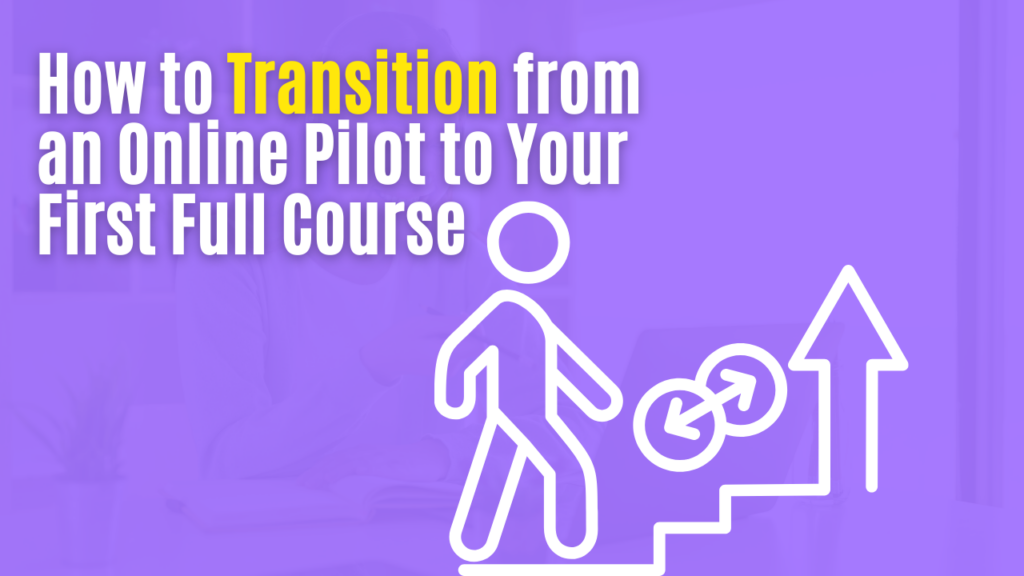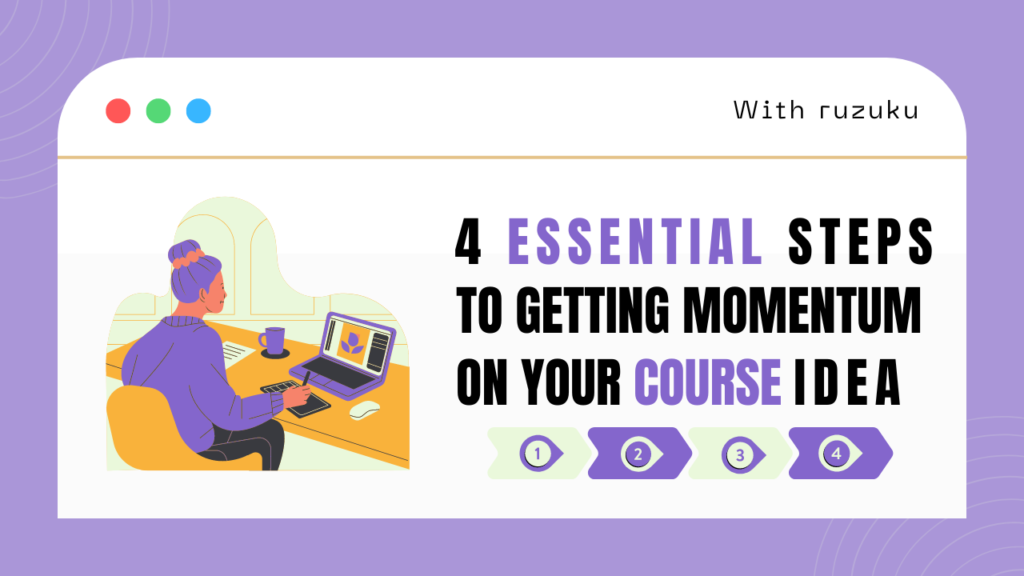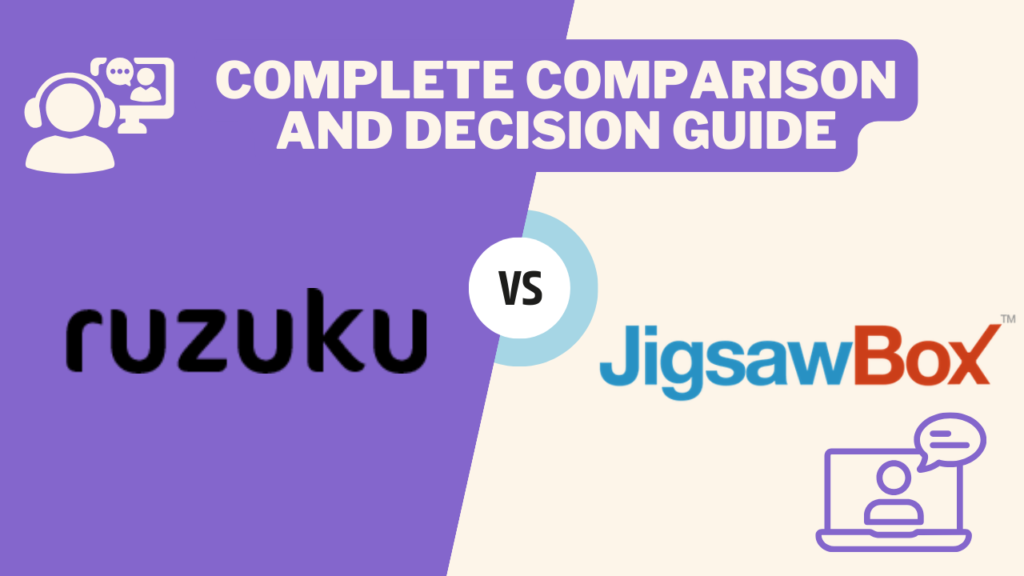Note to readers: This is the 3rd post in our series about running a pilot course. If you’ve been following along, great! If you’re new here, you can read parts one and two by clicking on the links.
You know how important it is to beta test your online course.
So you ran a pilot of the course material with a small group.
Maybe you got lots of great feedback from your pilot participants. But maybe you’re not sure how it went.
And now you’re wondering “what’s next?”
Most of the conventional wisdom says to test that people want and will pay for your idea and that you can deliver the expected results…
And then you turn it into a full course.
Poof!
Like magic.
But what really goes on behind the scenes when you transition from a pilot course to a full online course?
This post will navigate you through the whole process. Let’s start with what happens during the pilot.
Step 1: Play your part
Making sure that you get the right kind of feedback from your pilot students is critical to your success.
When you ran your pilot, you asked for feedback along the way. Perhaps you also sent out a survey to gather some final comments to keep the conversation going.
One of the keys to getting usable feedback is to ask good questions.
Ask the right questions
In a previous post we shared a set of questions you can ask. Here are some more:
- Overall, how has your course experience been?
- What have been your biggest takeaways or insights?
- What obstacles to your learning have you encountered?
- Anything else you’d like us to know?
- [optional] If you would like a reply to your response, with suggestions on how to move forward, please enter your name and email so we can get in touch:
- Name
You might also consider using a Net Promoter Scale to ask questions like:
“On a scale of 1 – 10, how likely is it that you would recommend this course to a friend? And, why did you choose that score?”
If you get answers that are a 9 or 10, that’s fantastic.
If the answers come back as a 7 or 8, that’s a fairly neutral score — they’re probably a happy customer, but they’re unlikely to become an ambassador for your courses.
But surveys might not give you the depth of feedback you’re looking for.
Appreciate the power of one
It’s preferable to hold one-on-one review calls with each of your pilot participants. You’ll be able to dig a lot deeper when you have a conversation. These calls can be somewhere between 15 to 30 minutes long.
 You’ll use a simple script that follows the same basic questions in the feedback survey.
You’ll use a simple script that follows the same basic questions in the feedback survey.
You can start with a friendly chat, catching up for a minute or two. Then dig into their overall experience with the course, including their key takeaways.
Dig in and ask clarifying questions.
Find out where they struggled or where things didn’t work the way you thought they would. This allows you to get to the root cause of the issue at hand, rather than just scratching the surface.
Some people will be very talkative and open about their experience, and some will give you minimal answers.
You’re looking for concrete answers that tell you why their experience was good (or bad). You may need to dig deeper.
But it’s one thing to know what you should do, and another to get in the right mindset to do it.
Recognize where you stand
Let’s look at something that trips up a lot of first time course creators — utilizing the feedback you received.
There’s a key mindset that is incredibly important when running your beta: you have to harbor a degree of detached skepticism.
Your course idea isn’t going to be perfect the first time so you will look for ways to change and evolve. You’re not locked in to this idea, and you are not your pilot course.
Now, this is often easier said than done. You’ve put a lot of creative energy into your course so far — and sometimes it can be hard to let go and be open to changing things.
To achieve this mindset, it can help to change from a place of “ego” where the course is all about you, your creative work, and your expertise. Instead, shift to a place of “service” where your course is all about helping your audience move forward.
You also want to feel that your hard work is paying off in some way. While it’s nice to hear validation from your students that they love your course, you should always look for ways to improve. The one-on-one review calls can also be very helpful here, as you get the tone of the conversation and the ability to dig deeper.
Treat this process like real research. Take structured notes so you can see what patterns emerge. And don’t rely on your memory to show you where the patterns are — you’ll want written evidence that you can review.
Next, you’ll dig in and analyze how things went.
Step 2: Examine the outcomes
There are many definitions of what makes a successful course, so how do you know what you can improve?
Let’s take a look at both the outcomes your students want and the structure of your course material.
Know what students want to learn
There are some important lessons you can learn from your pilot.
 The first and most important is to make sure that your intended learning outcomes lined up with what your participants wanted or expected to get out of the course.
The first and most important is to make sure that your intended learning outcomes lined up with what your participants wanted or expected to get out of the course.
You also want to find out how well people progressed toward the outcomes. What obstacles did they encounter on the way?
It’s critical to find out how motivated participants were to achieve the desired outcome. Did they actually want what you thought they would?
Sometimes, the idea you have going into your pilot isn’t 100% aligned with what people actually wanted. And that’s okay!
One of the reasons you run the pilot in the first place is to improve your understanding of what people can get out of the course.
Next, let’s dig into how your course material is set up.
Create the perfect framework
When most course creators think about improving and iterating their course, they focus on structure and content.
There are 3 areas that you can work on to make these improvements.
1. Improve through iteration
This process is much like editing a written work. You improve by writing a draft, editing it, editing it again, and finally ending up with a finished work.
Apply similar principles to your course:
- Look for ways to simplify.
- Reduce the amount of content wherever possible.
- Make your content easier to understand.
- Make sure that your content is easy for your students to apply.
- Create opportunities for your students to experience “small wins” that help them move forward.
- Eliminate areas of drag and make improvements to any places where your pilot students got stuck.
But there may also be content that just needs a little bit of refinement before it’s ready for your full course.
2. Polish and perfect
Look through your course material and see if there are things that are still in raw form from the pilot course. These could be quickly filmed videos, a presentation that you slapped together for a group call, or a really rough slide deck.
 For the full course, make these materials more professional.
For the full course, make these materials more professional.
Now that you know they work the way they should, you can invest the time (and money) to make them look and function their best.
It’s easier for most course creators to jump into this type of change, because they’re usually simple changes to put in place.
But remember, these improvements are just icing on the cake.
Make sure that you’re looking at the deeper questions — not just the surface changes that make your course “pretty”.
Look back at the intended learning outcomes and make sure that you’re creating a final form that has been tested and proven to work.
And don’t forget to look over the key areas of content from your course.
3. Complete the final touches
Review your course material as a whole and make sure that your changes haven’t altered the structure or flow of the course.
Make sure that the lessons still work together and that everything is leading to the desired learning outcomes that your students want to reach.
The difference between success and failure when doing your course review often comes down to your mindset.
Shift your perspective
Mindset also plays an important part when you do your course review.
You want to keep a degree of detached skepticism here as well. It’s much easier to fall into the trap of your own assumptions as you start making changes to the course.
Something that can help is talking through any changes with a friend, instead of trying to tackle them yourself. That way, you have someone by your side who can challenge you and ask you questions to make sure that you’re sticking to the feedback that you got in step one.
Keep the written feedback from your one-on-one calls handy and watch for the patterns that your course feedback provided.
Now you can start to look at creating a purchasing path for your customers to follow.
Step 3: Lay out the path
This step is important, but often under-utilized.
A lot of your revenue comes from leading your customers from one offering into the next — and the customer journey is much more impactful if you don’t leave them hanging at the end of your first course.
Propel your course to profitability
Many new course creators fall into the trap of thinking that because they only have one course, there’s nowhere else to lead their students.
 Don’t forget about offering services or coaching.
Don’t forget about offering services or coaching.
Even if you don’t have products to sell – or other high-end courses to offer – there’s still some way you can improve your customer’s life.
This allows you to earn more by serving people more deeply.
Successful course creators have this down to a science.
Look for opportunities to continue the relationship and lead your customer further down the path with you. You’ll both be happier in the long run.
Here are 3 ways you can get more revenue from your courses:
Offer options
By offering different pricing options for your course, you also increase the number of people you’re able to serve.
There are a few different ways to implement pricing tiers:
- Offer a level of personalized support, coaching, or consulting in addition to the course itself.
- Include the option of “done for you” services where you do the work for them.
- Give the option for follow-up support after the course is complete.
- Offer access to specific materials or content that isn’t included in the course.
- Create a community where they can interact with their fellow students during and after the course.
- Offer different price tiers for a live version of the class and a self-study version.
But maybe you’re looking for ways to increase your sales totals in the short term.
Add on to the offer
Much like the psychology behind fast food restaurants offering to “super size” patrons’ meals for a small additional charge, you can include upsells to your course participants.
You might give them a special offer related to the course after they’ve signed up – or completed – the current course.
For example:
In the past, we offered a significant discount on the first year of Ruzuku to everyone who completed our 30 Days to Your Online Course program.
Here are a few additional ideas for things to offer:
- Another course or program in your curriculum (what’s the logical next step after completing Course #1?)
- Access to ongoing support or community (a mastermind, membership or continuity program)
- Software, apps, or tools that complement your course (if you teach stress reduction, offer software that helps track and reduce stress)
- Physical products that enhance your course (if you teach productivity, offer a paper planner)
- Live events, workshops, or conferences
Or maybe you want recurring revenue, so that you don’t have to think about how to pay next month’s bills.
Set it and forget it
Getting customers set up on a subscription plan can be one of the best ways to create steady income for your course business.
This becomes especially important if your course participants are looking for ongoing support or continually updated content from you.
If you’re planning to offer subscriptions, find a payment processing platform that allows recurring (automatic) payments. You don’t want the headache of having to remember to manually enter payments every month!
Another way to increase the revenue from your courses is to funnel students into services that you offer, such as coaching or consulting.
Sell more services
Selling services brings more revenue in your door.
 And though doing one-on-one work for clients may not be your ideal situation, it can bring money in while you build up your course offerings.
And though doing one-on-one work for clients may not be your ideal situation, it can bring money in while you build up your course offerings.
Your course is the perfect vehicle to engage people and lead them naturally into your service offerings.
This could be coaching, consulting, writing, design, outsourcing, or any other service they might need.
Here are a few ways to sell more services:
1. Create a nurturing email autoresponder campaign
First, make sure that people are joining your email marketing list. You might have them do this before you even offer them the opportunity to register for your course.
Next, design a sequence of emails to nurture and engage these prospective clients. The key is to engage and educate first, before asking for a sale.
Nathalie Lussier wrote a great post that talks about what to do once you have your email list set up.
2. Offer free strategy or mini-sessions
Many coaches and consultants enroll new clients by offering a free “strategy session” call.
Give your course participants the opportunity to sign up for a free session inside your course. You can use an appointment booking service such as Appointlet to make this easy.
3. Provide a personalized worksheet review
Worksheets are a powerful way to help participants take action.
Provide a worksheet that draws out their challenges through questions and prompts. Then offer to review their worksheet on a 20-minute call.
You can flow naturally from discussing their challenges and next steps based on the worksheet responses to a service offer that would meet their needs.
4. Host group Q&A or coaching calls with a special offer
A great way to engage your community is with question & answer or group coaching calls.
People love having the opportunity to get more personalized help and ask you questions. You can end these calls with a call to action to sign up for a special offer — such as service package or a premium course.
5. Integrate upsells via links and buttons
A simple option in a free or low-cost course is to include upsells in activities throughout the course.
Help people get value from your techniques, then show them an offer to go deeper with a premium course or service package.
To provide a strong call to action, consider including a graphical button (rather than just a text link) in your activity. Have the button link to a sales page on your website.
6. Plan a structured launch of a “special value” limited-time service package
No matter what kind of service you’re offering, deadlines and urgency can help people make a decision about the offer.
Get creative about how you can offer your service in a time-limited way.
For example:
Put together a special 3- or 6- month coaching package with specific goals and bonus materials, and offer it at a discounted price for a limited time. Then plan an email campaign to introduce the package to your course participants and give them clear reminders about the deadline.
Your final step is to figure out how you will market your full course.
Step 4: Prepare to make the sale
A common mistake that new course creators make is thinking that they can market the full course like they marketed the pilot.
 The purpose for running your pilot is to validate that people will pay for your course, and that you can deliver the results they want.
The purpose for running your pilot is to validate that people will pay for your course, and that you can deliver the results they want.
As you start to put together your launch plan for your full course, you’ll tell the story in a fuller, more developed way.
Since we’ve talked so much about marketing and launching your online course in other posts, this post won’t cover any of that material.
Instead, here are the other posts you can explore as you’re getting ready to market your full course:
Make sure that you’re using the right marketing tactics for your current stage of business.
Set yourself up for success by creating a course that practically sells itself. And get rid of some of the “ick” factor that turns a lot of people off marketing their courses.
We’ve also pulled in the experts to look at the challenges you face when marketing and launching (did we mention launching?) your online courses.
When you’re ready to launch, get started with your launch planning in a way that makes your life easier. Then take the next steps to make the most of your course launch. We also wrote posts about running your first webinar, and creating a compelling sales letter.
So there you have it. Four steps for taking your course from rough pilot to polished final version.
Take the next steps
You’ve run your pilot.
You’ve validated that your course idea is something that people will pay for, and that you can deliver the results that you promised.
Now it’s time to take your course through its paces and turn it into the masterpiece that you know it can be.
This post has outlined each of the steps to get you from pilot to finished full course.
What are you waiting for?
Get that amazing full course out into the world. Your audience is counting on you!
Have you run your pilot yet? Are you ready to see your course transform from the rough draft pilot into a professional course? Let us know in the comments![/fusion_builder_column][/fusion_builder_row][/fusion_builder_container]




